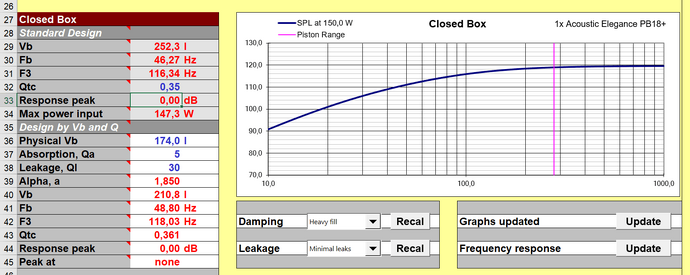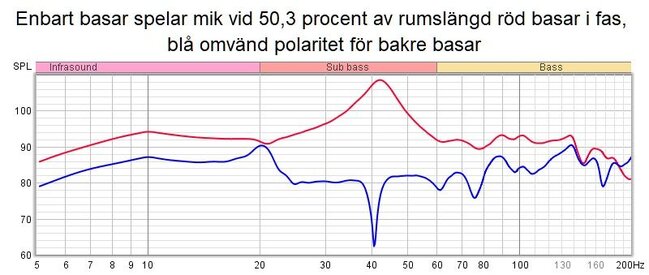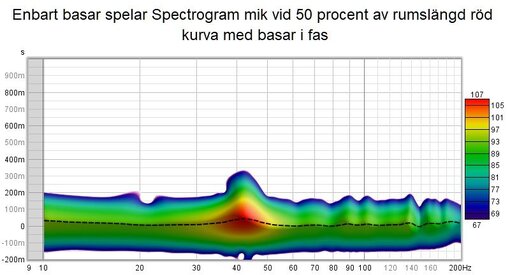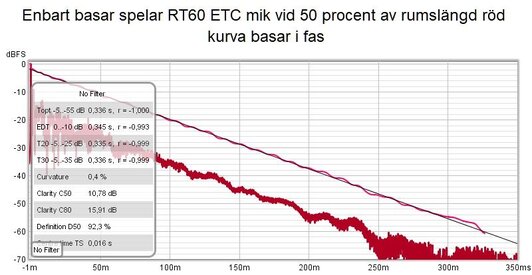I agree with Matthew, room gain and pressure gain (= for frequencies below the rooms lowest mode frequency) is something which can be very important when planning a listening / HT room from scratch or choosing subs / DIY-ing them.
My room is 7,86 m long (25,8 ft). With all surfaces in 20 cm / 8” or thicker concrete and small windows and half of it below ground level, theoretically the lowest room mode is about 21,8 Hz. As a concrete bunker I expected quite a lot of room and pressure gain and wanted to avoid a boomy bass as much as possible while at the same time wanting high SPL in the infra. So, when my DIY subs where built I went for sealed boxes and simulated for a very low Qtc of 0,36 instead of “usual” 0,707. Simulation then showed boxes with resonance frequency (Fb) of 48,8 Hz and a -3 dB (F3) as high as 118 Hz. The simulation showed the speaker in free air should be down -20 dB at 20 Hz. Pretty bad eh? Who wants a sub which is down 3 dB already at 118 Hz. Here is where room and pressure gain come in and makes up for a lot.
The diagram with the red and blue curve, have no smoothing, no EQ and no time delay applied, with subs at front wall and rear wall. (Yes, I know the curves look smoothed but they aren’t.) Microphone is placed in the vey middle of the room, where one has a minimum SPL of lowest room mode and a peak for 2nd length mode. Red curve is with subs at front wall playing in phase with subs at the rear wall. Blue is with subs at the rear wall playing with opposite polarity versus front subs (180degree out of phase). Notice the SPL at 120 Hz is 91 dB and at 20 Hz it is also 91 dB. Not 20 dB down to 71 dB or so, as from the simulation. The substantial room gain in the concrete bunker is the cause for the same value at both 120 and 20 Hz. A few Hz below lowest room mode frequency, the pressure gain starts to show up and SPL rises to 96 dB at 10 Hz. Higher than both at 20 and 120 Hz. It is actually about 103 dB if one is to trust the calibration file for my UMIK 1. At 10 Hz it shows 7,4 dB too low value. Under 10 Hz there is a filter in the electronics so the SPL starts to fall again.
The red curve shows a huge peak for 2nd room mode around 42 Hz with all subs in phase, and a deep dip for the blue curve when subs have opposite polarity. If the rear subs had been time delayed, it would be more or less flat at around 40 Hz. The peak can easily be EQ:ed down so it is less noticeable. Actually it is not very noticeable even without any EQ. At around 40 Hz it takes only about 0,34 seconds to drop 40 dB as can be seen in the Spectrogram, so the peak doesn’t linger on for eternity. The rest of the bass has even lower decay rate. The same figure 0,34 seconds shows up in the ETC for a 60 dB decay with a more or less a straight line for the Schroeder integral curve.
Conclusion: A strong room and pressure gain can be used to your advantage, -no beefy power amps for mega bucks may be needed when aiming for high SPLs in the very low bass. (In the diagrams less than 1 W / channel goes out from the amp if I remember correctly.) It can also turn out disastrous with a too boomy bass which is impossible to “cure” with any normal bass traps if one doesn’t take it into consideration beforehand.














